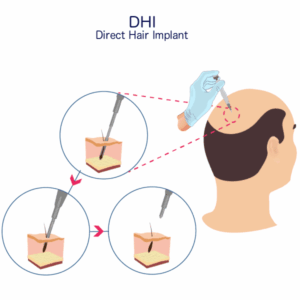
DHI for Afro Hair Transplant: Everything You Need To Know

September 20, 2025 by
avrupahairtransplant
DHI for Afro hair transplant (Direct Hair Implantation) isn’t a magic wand; it’s a graft placement method that can be brilliant for Afro-textured hair when it’s used for the right reasons and with the right hands. Coiled follicles demand careful control of depth, angle, and curl direction at the hairline and temples. DHI implanter pens can help deliver that control. But there are trade-offs: pace, team skill, device gauge, and how well extraction was done all influence whether DHI actually improves your outcome.
This guide explains where DHI for Afro hair shines, how to plan densities without starving grafts, and the practical steps surgeons use to keep curl direction natural.
What is DHI?
DHI is a hair graft placement technique, not an extraction method. Most DHI cases still use FUE to extract and harvest grafts; the pen is used to place them. The pen loads a graft into a hollow needle then the surgeon presses the pen to create the site and place the graft in the scalp in one motion.
Whether pens outperform forceps or pre-made slits depends on operator skill, graft quality coming out of FUE, and case selection.

Is DHI good for Afro hair transplants?
Yes, in the right hands and for the right areas. DHI (implanter-pen placement) is especially helpful for Afro hairlines and temples because it gives precise control of depth, angle, and curl direction, making baby-hair zones look soft and natural. It also works well when placing between existing hairs and can reduce handling time for delicate single-hair grafts.
What DHI doesn’t change is the upstream work: you still need excellent FUE extraction tailored to coiled follicles (low transection), smart density planning (no overpacking), and stable scalp health (no active traction or CCCA). For very large coverage (mid-scalp/crown), many surgeons use a hybrid approach—pens for detail zones and pre-made slits/forceps where speed and efficiency matter.
Bottom line: DHI can be an excellent choice for Afro hair—especially at the hairline and temples—if the surgeon is experienced with coiled follicles and pairs it with high-quality FUE and measured, staged density.
In Which Cases Does DHI Help Most in Afro Hair Transplants?
1- Hairline detail and temples
- Low exit angles and micro-irregularity are vital for a natural Afro hairline. Pens act like a “mechanical memory,” helping the operator keep angles consistently low while seating single-hair grafts in a tight, feathered band.
- Temple peaks benefit from precise angle control. Pens make it easier to plant at the natural back-and-down vector without the graft buckling as it enters.
2- Dense work between existing hair
- In areas with remaining native hair (early recession, partial edges), pens can reduce accidental trauma to surrounding follicles by combining site creation and placement in one controlled action.
3- Speed-to-scalp for fragile grafts
- Proper DHI workflow can shorten out-of-body time for singles used in the front band, reducing drying risk—if the team loads efficiently and keeps grafts hydrated on the tray.
4- Curl-direction fidelity
- For tightly coiled hair, pens allow the surgeon to “clock” the bevel and pre-set curl direction as the graft is seated, making the emerging coil lie naturally rather than stick up or cross neighbors.
Where DHI is less ideal: very large coverage cases (e.g., big mid-scalp + crown) where pre-made slits and rapid forceps placement may be faster and equally precise in experienced hands.
Density Planning for Afro Hair Transplants
Coiled, coarse shafts create stronger optical density per graft. You don’t need to chase extreme numbers to look full, and pushing too high in one pass can compromise growth.
- Hairline/frontal band (Afro/coily): many surgeons target about 30–40 grafts/cm² using DHI or mixed technique, with a 5–8 mm feather band of singles at the very front.
- Edges/temples (Afro women): often 25–35 grafts/cm², emphasizing fine singles and a gentle taper into the temple curve.
- Mid-scalp: 25–35 grafts/cm² for blending, staged if needed.
- Crown: usually under-built initially to conserve donor; pens can still be used around the whorl, but this zone is rarely first priority.
Why not 60–70 grafts/cm² everywhere?
Because recipient skin has a blood-supply limit. Over-dense packing in one pass can collapse microcirculation, increase swelling, and raise failure risk. Better to stage density: create a natural frame now, then reinforce months later if needed.
Curl-Direction Control with Implanter Pens
The surgeon sketches flow lines across the front—straight down in the center, fanning laterally, then sweeping back/down in the temples. This becomes the “compass” for pen orientation. Single hair follicles are placed at the front and are often loaded in smaller needles; whereas doubles are placed behind and may need a size up. A snug fit prevents twisting or compression of the graft as it enters.
DHI’s depth control helps avoid low seating (grafts sink) or high seating (popping out). Consistent depth equals consistent curl emergence. The pen is “clocked” so the bevel matches the expected curl path. In coiled hair, that reduces kinks or crossed coils when the hair grows out.
Afro hairlines look most natural with very low angles close to the skin and the pens help keep that angle steady across hundreds of placements. The front 5–8 mm gets fine singles with micro-irregularity. Then doubles are layered just behind to create depth while keeping the rim soft.
DHI vs Pre-Made Slits/Forceps
Potential DHI advantages
- One-step site + placement can minimize handling and maintain angle consistency.
- Good for detail zones (hairline/edges/temples) where tiny deviations are obvious.
- Helpful in diffuse areas to avoid tangling with native hair.
Potential DHI trade-offs
- Team dependence: pens are only as good as the graft loaders and the surgeon’s technique. Poor loading crushes bulbs.
- Pace in megasessions: for very large areas, pre-made slits + rapid forceps placement can be faster without sacrificing precision when the surgeon is experienced.
- Device dogma: no pen brand guarantees results; outcomes ride on extraction quality, hydration, angle discipline, and post-op care.
Practical takeaway: many top clinics use a hybrid approach—pens for hairline/temples and forceps/slits for larger fields.
Extraction Quality Still Rules (DHI Can’t Fix Bad FUE)
DHI happens after FUE. If extraction damaged follicles (high transection), the pen won’t revive them. Protect yield by ensuring your surgeon uses curvature-aware punches, controlled motion, and tracks transection rate in real time. Healthy grafts in → healthy grafts out.
FAQs
Is DHI always better than forceps?
No. It’s a tool, not a guarantee. In the hands of a skilled team, pens excel in detail zones and between native hair; for large fields, either method can be excellent.
Will DHI give me higher density?
It can help place densely with accurate angles, but true density depends on donor supply, vascular limits, and extraction quality. Overpacking in one pass can hurt growth—staging is often wiser.
What pen size should be used?
It depends on graft size. Singles up front require smaller-gauge needles; doubles behind need slightly larger. The fit should be snug without crushing the graft.
Can DHI reduce scarring?
Recipient dots are tiny with any micro-site technique when done well. Visible scarring relates more to extraction patterns and how your skin heals than the choice of pen vs forceps.
Bottom line
DHI shines in Afro hair transplants when it’s used for what it does best: precise, low-angle placement of singles at the hairline and temples, with curl-direction control baked into every insertion. But pens don’t replace fundamentals. Your result still depends on excellent FUE extraction, measured density planning (often ~30–40 grafts/cm² in the front for coily hair), strict hydration/handling, and a team that can prove its Afro-case outcomes.
DHI for Afro Hair in Turkey
From low-angle hairlines to natural temples, DHI pens can make a difference for Afro-textured hair transplant in Turkey when the fundamentals including follicle extraction quality, donor math, and curl-respecting angles are all in place. We integrate DHI for detail zones with proven Afro-FUE methods, giving patients results that last without wasting donor supply.
Written By
avrupahairtransplant
Avrupa Hair Transplant Clinic, Istanbul’s trusted name since 2006, transforms hair restoration with cutting-edge techniques like FUE, DHI, and Sapphire, crafting natural, lasting results. With over 40,000 success stories and a collection of international awards, Avrupa blends innovation with artistry, delivering personalized care that redefines confidence for clients worldwide.